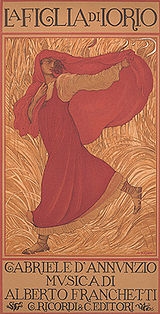
La figlia di Iorio
Encyclopedia
La figlia di Iorio sometimes written as La figlia di Jorio, is an opera
in three acts by Alberto Franchetti
to a libretto
by Gabriele D'Annunzio
. The libretto is a very close rendering of D'Annunzio's play of the same name. La figlia di Iorio premiered at La Scala
on March 29, 1906, conducted by Leopoldo Mugnone
. Although the play, which had premiered two years earlier, was considered one of D'Annunzio's greatest works, the opera did not achieve a comparable success and has been rarely performed since its day.
,_la_figlia_di_iorio_(1914).jpg)
and duet from La figlia di Iorio with two singers from the original cast:
Opera
Opera is an art form in which singers and musicians perform a dramatic work combining text and musical score, usually in a theatrical setting. Opera incorporates many of the elements of spoken theatre, such as acting, scenery, and costumes and sometimes includes dance...
in three acts by Alberto Franchetti
Alberto Franchetti
Alberto Franchetti was an Italian opera composer.-Biography:Alberto Franchetti was born in Turin, a Jewish nobleman of independent means. He studied first in Venice, then in Dresden under Felix Draeseke, and finally at the Munich Conservatory under Josef Rheinberger. His first major success...
to a libretto
Libretto
A libretto is the text used in an extended musical work such as an opera, operetta, masque, oratorio, cantata, or musical. The term "libretto" is also sometimes used to refer to the text of major liturgical works, such as mass, requiem, and sacred cantata, or even the story line of a...
by Gabriele D'Annunzio
Gabriele D'Annunzio
Gabriele D'Annunzio or d'Annunzio was an Italian poet, journalist, novelist, and dramatist...
. The libretto is a very close rendering of D'Annunzio's play of the same name. La figlia di Iorio premiered at La Scala
La Scala
La Scala , is a world renowned opera house in Milan, Italy. The theatre was inaugurated on 3 August 1778 and was originally known as the New Royal-Ducal Theatre at La Scala...
on March 29, 1906, conducted by Leopoldo Mugnone
Leopoldo Mugnone
Leopoldo Mugnone was an Italian conductor, especially of opera, whose most famous work was done in the period 1890-1920, both in Europe and South America...
. Although the play, which had premiered two years earlier, was considered one of D'Annunzio's greatest works, the opera did not achieve a comparable success and has been rarely performed since its day.
Roles
,_la_figlia_di_iorio_(1914).jpg)
| Role | Voice type | Premiere cast 29 March 1906 |
|---|---|---|
| Aligi | tenor Tenor The tenor is a type of male singing voice and is the highest male voice within the modal register. The typical tenor voice lies between C3, the C one octave below middle C, to the A above middle C in choral music, and up to high C in solo work. The low extreme for tenors is roughly B2... |
Giovanni Zenatello Giovanni Zenatello Giovanni Zenatello was an Italian opera singer. Born in Verona, he enjoyed an international career as a dramatic tenor of the first rank. Otello became his most famous operatic role but he sang a wide repertoire. In 1904, he created the part of Pinkerton in Madama Butterfly.-Career:Zenatello... |
| Candia della Leonessa | mezzo-soprano Mezzo-soprano A mezzo-soprano is a type of classical female singing voice whose range lies between the soprano and the contralto singing voices, usually extending from the A below middle C to the A two octaves above... |
Eleonora De Cisneros |
| Crocifero | bass Bass (voice type) A bass is a type of male singing voice and possesses the lowest vocal range of all voice types. According to The New Grove Dictionary of Opera, a bass is typically classified as having a range extending from around the second E below middle C to the E above middle C... |
Libero Ottoboni |
| Favetta | mezzo-soprano | Maria Bastia Pagnoni |
| Ienne dell'Eta | bass | Mansueto Gaudio |
| Lazaro di Roio | baritone Baritone Baritone is a type of male singing voice that lies between the bass and tenor voices. It is the most common male voice. Originally from the Greek , meaning deep sounding, music for this voice is typically written in the range from the second F below middle C to the F above middle C Baritone (or... |
Eugenio Giraldoni Eugenio Giraldoni Eugenio Giraldoni was an Italian operatic baritone who enjoyed a substantial international career. In 1900, he created the role of Baron Scarpia.... |
| Mielitore | bass | Adam Didur |
| Mila di Codra | soprano Soprano A soprano is a voice type with a vocal range from approximately middle C to "high A" in choral music, or to "soprano C" or higher in operatic music. In four-part chorale style harmony, the soprano takes the highest part, which usually encompasses the melody... |
Angelica Pandolfini |
| Ornella | soprano | Adele D'Albert |
| Splendore | soprano | Teresina Ferraris |
Recording
Souvenirs from Verismo Operas - Volume 1, International Record Collectors' Club (IRCC 812) contains an ariaAria
An aria in music was originally any expressive melody, usually, but not always, performed by a singer. The term is now used almost exclusively to describe a self-contained piece for one voice usually with orchestral accompaniment...
and duet from La figlia di Iorio with two singers from the original cast:
- 'Rinverdisca per noi' sung by Giovanni Zenatello
- 'Che c'è egli, Aligi!' sung by Eugenio Giraldoni and Giovanni Zenatello
External links
- Gabriele D'Annunzio, La figlia di Iorio, full text of the original play (in Italian)

